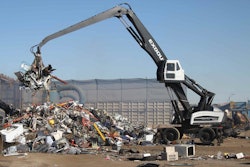Wright Express Corp., a provider of value-based business payment processing and information management solutions, in collaboration with IHS, a global source of information and analysis, has released results of its Wright Express Construction Fuel Consumption Index (FCI), which indicated a decrease of 3.4 percent in January versus its level the previous year.The Wright Express Construction FCI measures national fuel consumption statistics for the construction industry, which provides an accurate and up-to-date indication of construction activity in the United States. The construction segment comprises nearly 20 percent of the Wright Express portfolio of customers.
Wright Express worked with IHS to capture and analyze transaction data from its closed loop network of more than 180,000 fuel and vehicle maintenance locations, including over 90 percent of the domestic retail fuel locations and 45,000 vehicle maintenance locations. With this data, the Wright Express Construction FCI can be used to identify emerging trends within the construction industry and the national economy.
The indicators were tested at monthly, quarterly, and annual frequencies, with the greatest insights produced using the year-over-year percent change of the monthly data. For January 2012, the Wright Express Construction FCI reported that fuel consumption by U.S. construction companies decreased by 3.4 percent versus January 2011 and decreased by 2.1 percent versus the previous month.
The analysis of the recently released construction data shows mild improvement for the construction industry. There were 21,000 nonresidential sector jobs added in January, and total construction put-in-place expanded 1.5 percent in December. Construction spending excluding improvements – a better measure of activity – was up a solid 1.8 percent.
The Wright Express Construction FCI, which is available monthly in advance of the U.S. Census Bureau figures on construction spending, is available at www.wrightexpress.com/fci.
January 2012 Wright Express Construction Fuel Consumption Index (FCI)
According to the Wright Express Construction FCI, a full recovery is still a long way off, but the construction industry is expected to improve in 2012. Additionally, while continued infrastructure spending is expected to decline moderately over the course of 2012 as state and local governments are faced with budgetary constraints, it increased again in December by 1.1%.
IHS Analysis
According to the IHS analysis, the January result of the Wright Express Construction Fuel Consumption Index indicates that the state of the U.S. construction industry may not be as positive as recent construction data suggests. While the seasonally-adjusted index was nearly flat in December and fell in January, some construction industry data have shown growth in recent months. Growth in these indicators must not be overemphasized, as the level of spending in the industry remains very low. In the past two months, construction employment has grown by 52,000 jobs, but the industry still employs 2 million fewer people than it did at its peak in 2007. Growth in the housing market will accelerate in 2013, but conditions will not return to normal until about 2015, when housing starts finally climb above the 1.5-million threshold.
The Wright Express Construction FCI for January 2012 is available at www.wrightexpress.com/fci.
Index Methodology
The Wright Express Construction Fuel Consumption Index (Wright Express Construction FCI) was developed by IHS Global Insight with support from Wright Express. The index is based on monthly fuel consumption statistics for the construction industry tracked by Wright Express’s comprehensive fuel consumption database. The Wright Express Construction FCI provides unique fuel transaction information that can be used to identify emerging trends in the construction industry. By tracking the volume of fuel consumed by construction companies in the United States, the index provides an accurate and up-to-date indication of construction activity in the country.
The construction industry was defined by 1987 Standard Industry Classification (SIC) codes 15 (General building contractors), 16 (Heavy construction contractors), and 17 (Special trade contractors). Data from Wright Express’s fuel transaction database was “cleaned” based on a criteria developed by IHS Global Insight with input from Wright Express. The sample included only accounts that had been active for at least two years. In this way, IHS Global Insight was able to effectively capture the construction market’s fuel consumption activity. In order to create an accurate index, the fuel consumption data from each SIC industry code were weighted based on the number of companies in each industry.
IHS Global Insight analyzed the relationship between 16 different construction and housing indicators and the construction sector fuel consumption data provided by Wright Express. Correlation tests were conducted on each of the indicators against the volume of gallons consumed, the volume of gallons consumed per effective fueling day, the volume of gallons consumed per active card per effective fueling day. All series were tested at seasonally adjusted rates, as well as non-seasonally adjusted rates.
The indicators were tested at monthly, quarterly, and annual frequencies. We found that the greatest insights were produced using the year-over-year percent change of the monthly data. After determining the top three indicators, additional correlation tests were conducted to determine the optimal transformation of the Wright Express fuel consumption data.
Through this analysis, it was revealed that the Wright Express Construction FCI for construction was a particularly strong indicator of the value of total construction put-in-place and construction industry employment in the United States. The overall correlation based upon monthly year-over-year growth rates from January 2002 to January 2012 was 0.898 for the number of new single-family homes for sales and 0.878 for total construction put-in-place.
| Indicator | Correlation | |||
| New Single-Family Homes for Sale | 0.898 | |||
| Total Construction Put-in-Place | 0.878 | |||
| New Single-Family Homes for Sale – Under Construction | 0.871 | |||
| Construction Employment | 0.857 | |||
| Total Private Housing Under Construction | 0.840 | |||
| S&P/Case-Shiller Home Price Index – Composite 20 Index | 0.833 | |||
| Average Sales Price of Existing Single-Family Homes Sold | 0.822 | |||
| Residential Construction Put-in-Place | 0.741 | |||
| New Single-Family Homes Sold – Completed | 0.716 | |||
| Average Sales Price of New Single-Family Homes Sold | 0.702 | |||
| Total Housing Completions, Private | 0.697 | |||
| Median Sales Price of New Single-Family Homes Sold | 0.657 | |||
| New Single-Family Homes Sold | 0.497 | |||
| Housing Permits, Private | 0.471 | |||
| Total Private Housing Starts | 0.466 | |||
| Nonresidential Construction Put-in-Place | 0.448 | |||
| New Single-Family Homes Sold – Under Construction | 0.262 | |||
Source: Wright Express













